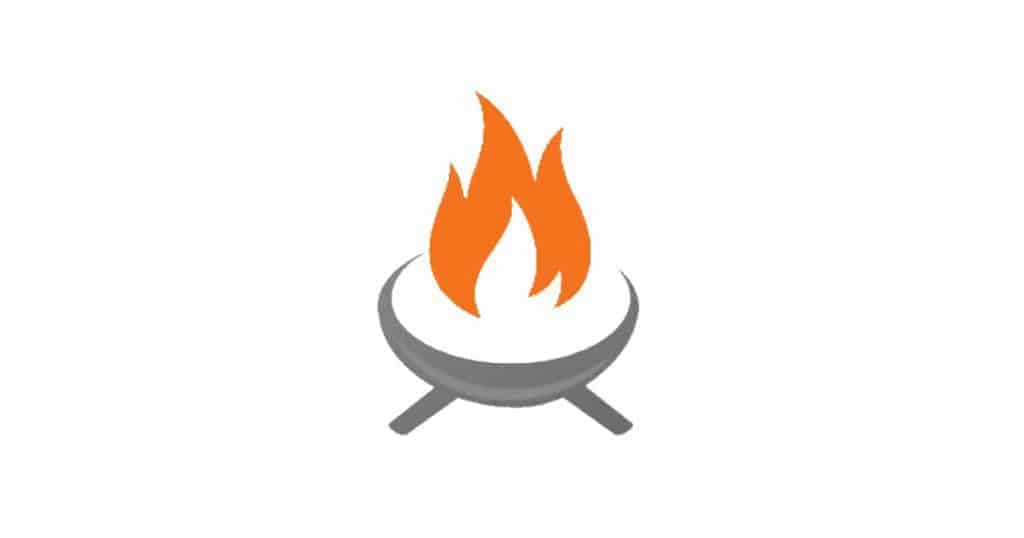By J. Herwick
We use affiliate links and may receive a small commission on purchases.
Read more about us.
If you are a regular fire pit (or fireplace) user, you’ve most likely heard of kiln-dried firewood and maybe even used it.
This type of firewood provides a lot of upside for the fire pit user at a slight, but well worth it, premium over conventionally seasoned firewood.
If you buy your firewood vice chopping it yourself or are considering other options, read on and I’ll bring you up to speed on kiln-dried firewood and why you might want to consider using it in your next fire pit burn.
Kiln-dried firewood holds several advantages over wood that has been chopped, stacked, and dried by the air and exposed to the sun over a period of time. It’s…
- Ready to burn immediately
- Easier to start and stays lit
- Hotter burning
- Low-smoking
- Free of bugs, fungus, and mold
If you are not familiar with some of the terms mentioned, keep going and we’ll cover them as we move along.
What Exactly is Kiln-Dried Firewood?
Kiln-dried firewood is the output of a process that reduces the moisture content of “green,” or newly chopped wood, to 20% or less.
Conventionally seasoned firewood (done via air drying/sun exposure over an extended period) typically has a moisture content in the 25-30% range. Not optimal, but good.
As the name “kiln dried firewood” implies, green wood is placed in a large kiln specifically designed to season firewood and dried at a certain temperature for a certain period of time.
Seasoned firewood, for those not familiar with the term, is wood that has sufficiently dried to at or below the 30% moisture content level mentioned above, either by aging the wood outdoors in the open or with overhead protection.
The seasoning is accomplished through exposure to dry air, prevailing winds, sunlight, etc.
Getting back to kiln-dried wood…

The Advantages of Kiln-Dried Firewood for Fire Pit Use
Using kiln-dried firewood in any fire is optimal, but for fire pit users, there are a few more benefits that solve common backyard fire pit pain points.
I’ll elaborate while going over the advantages highlighted at the beginning of the article.
Kiln-Dried Firewood is Ready to Burn Right Away
Kiln-dried firewood is ready immediately, no 6-18 month seasoning period is required.
Because the firewood is already at the optimum 20% or lower moisture content, it is ready to burn the moment it is delivered.
No testing the moisture content like you might do with a conventionally seasoned firewood delivery.
It Lights More Easily and Requires Minimal Effort to Keep Lit
Compared to conventionally seasoned firewood (i.e. sun and air-dried), kiln-dried firewood’s very low moisture content facilitates quicker lighting and burning and less effort watching whether the fire is going to stay lit and having to react when it doesn’t.
Very dense kiln-dried hardwoods, like oak or hickory, may require a little more effort to get them going but once they start to burn, that’s it.
See my article How to Start a Fire Pit for getting your fire started right using, kindling, tinder, and a number of other fire starter options.
If you are outside trying to get your fire pit lit, particularly in the dead of winter, getting the fire started quickly is a top priority, especially if you have cold and potentially impatient guests.
Fooling around with firewood that may or may not light quickly is not something you’re likely to want to deal with.
Having a dry, fire-pit-ready source of fuel on hand, like kiln-dried wood, will make the job a lot easier.
It Burns More Efficiently, Giving Off More Heat
With kiln-dried firewood, all of the wood’s energy is directed to heat production and not to residual moisture burn-off.
Because of this, you’ll have a hotter fire, requiring less wood to keep the fire going and everyone warm around the fire pit.
The bottom line, when the wood is not dry enough, it burns inefficiently requiring more of it to do the same as adequately dried wood.
If you’ve got limited firewood storage space, maintaining a stash of kiln-dried firewood is a good option for the money as you’ll get a better, more efficient fire pit burn with much less wood being thrown on the fire.
It’s Low to No Smoking Due to Low Moisture Content
Damp firewood smokes…badly. If you’ve ever been around a fire pit and had to move every time the wind shifts then you know the deal.
Well-seasoned dry hardwoods give off little smoke, which is what you get with low moisture content kiln-dried wood.
With fire pit use up these days, complaints from neighbors about fire pit smoke are becoming more and more common.
Kiln-dried firewood can be a lifesaver, in this case, keeping smoke and your neighbor’s dirty looks to a minimum.
No Surprises From Uninvited Pests
An additional benefit of the kiln drying process is the elimination of insects, fungus, and mold from wood.
This is of particular benefit if you would like the option of storing firewood inside your home or garage.
This benefit, which actually may be the main reason for the growth in the processing and distribution of kiln-dried firewood, comes from the U.S. Department of Agriculture’s effort to prevent the spread of the emerald ash borer, an invasive insect species.
As part of their effort to do so, the USDA certified firewood kiln facilities to ensure they are in compliance with Federal regulations designed the slow the spread of this insect and others.
Firewood processed in these facilities is authorized to be sold across state lines whereas regular firewood seasoned conventionally can not.
Check out the site dontmovefirewood.org for more on the effort to control the transport of invasive species through firewood.
The Firewood Kiln Drying Process
There’s really not much to the firewood drying process and it can be done year-round allowing sellers to stockpile wood for sale, unlike vendors who use conventional drying or seasoning, which is typically done outdoors.
The process:
- Green firewood intended for kiln drying is cut into lengths of anywhere from 12 to 24 in. and split
- The split pieces are then placed into the firewood kiln where they will dry for 48 to 72 hours at 200° to 250° F
- The processed firewood is then removed from the kiln when the optimum moisture content is reached and USDA-specified wood temperatures are achieved
- Once removed from the firewood kiln, the wood will have lost close to half its weight in water and all insects, fungus and mold will have been eliminated
Kiln-Dried Firewood Prices
To show the cost range of a cord of firewood I used a sampling of 6 U.S. firewood sellers spread throughout the United States.
| What is a cord of wood? A cord of wood is a stack of split, or sometimes unsplit, firewood measuring 4 x 4 ft. x 8 ft. (128 cubic feet). |
The prices below represent a cord of kiln-dried oak firewood delivered in the vendor’s local service area (as of Aug 2019). What is considered “local” varies by vendor.
Note: I did have some difficulty finding firewood vendors in the western U.S who sold kiln-dried firewood by the cord. Many either didn’t show their prices or sold firewood in size configurations specific to their business. Apologies to everyone in that part of the country. I’ll keep looking.
This is obviously not a broad sampling but it should give you a general idea of what the current price range of kiln-dried firewood cords is in the U.S.
A firewood cord is anywhere from 600 to 750 split pieces which may be much more than you need or are able to store.
Many vendors sell fractional cords of wood (i.e. small bundles and third and half cords – a.k.a. face cords) so make sure to ask about their availability when looking for local firewood for sale.
The average of the prices listed above is $520/cord of oak. Some types of wood will be higher in price than oak and some will be less, but oak provides a good middle ground when gauging price across the many kiln-dried firewood options.
Kiln-dried firewood near me can be pretty expensive, as highlighted by firewood supplier #1 on the list above, Five Star Firewood. In their defense, their service area is right outside of Washington D.C., where everything costs more.
Two other suppliers, one in Seattle proper and one in Aurora IL, a Chicago suburb, have higher prices as well, so expect to pay more if you live near a major city where demand and the cost of doing business are higher.
The bottom line though is to expect about a 30% premium on kiln-dried firewood vs. seasoned wood.
Conclusion: Kiln-Dried Firewood Advantages
As we covered, kiln-dried firewood is a great option for fire pit use.
There’s a minimal fuss to light it, it burns very hotly, there’s less fire pit smoke, and all the bugs and other bad stuff are “cooked” away during the drying process.
As mentioned, it does cost a little more, but the common firewood challenges it solves may make it well worth it to you.
If you are a regular fire pit user you are not going to need anywhere near a full cord unless you are using the wood in your home fireplace as well.
Try a bagged or small bundle option, or a third or half cord to try it out if your firewood seller offers any of those size options.
If you are serious about your firewood, you won’t be disappointed.
For more about choosing the right firewood for your fire pit, check out my article Best Burning Firewood for Your Fire Pit.
Also, check out my post How to Stack Firewood for Your Fire Pit for tips on the right way to keep it dry and ready to burn at any time!
Thanks for reading.
John

